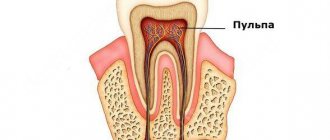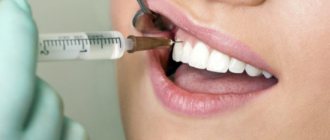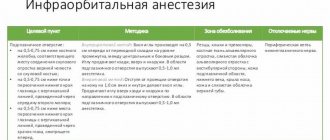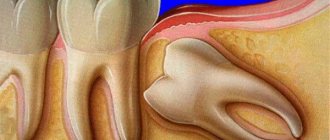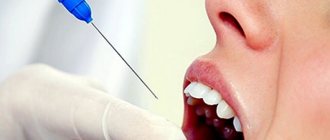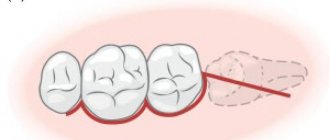It is almost impossible to find a person who does not know what toothache is. Many physiological (eruption) and pathological processes in the oral cavity (caries, pulpitis, etc.), as well as medical procedures, including tooth extraction, are accompanied by pain. It is a known fact in dentistry that smoking causes teeth to become more sensitive to pain.
What kind of anesthetic for teeth, including wisdom teeth, is used when therapeutic treatment or removal is carried out in dentistry, and what can be used at home for toothaches?
When deletion is indicated
There are indications for which wisdom teeth are always removed. These include:
- Too dense arrangement of teeth is the so-called crowding of teeth. This leads to difficulties with the eruption of the wisdom tooth, as a result of which it grows crookedly and causes serious pain. When teeth are impacted, infectious and inflammatory processes in the oral cavity are often observed. These problems can only be solved by removing pathologically located wisdom teeth.
- When there is a malocclusion or crooked teeth, orthodontists most often prescribe the installation of braces. The process of wisdom teeth erupting displaces the entire dentition, and this can cause pain when wearing braces. To avoid this problem, wisdom teeth are removed in advance, even if the process of eruption has not yet begun.
- Dental diseases of the wisdom tooth (pulpitis, periodontitis, caries) become a common reason for its removal. Therapeutic methods for treating such a tooth are associated with serious difficulties, and the tooth itself does not provide any useful function. Therefore, you can get rid of a diseased wisdom tooth without regrets.
The wisdom teeth removal procedure can be performed under local or general anesthesia. Indications for the use of general anesthesia include:
- inadequate psychological state of the patient, panic;
- More than one tooth needs to be removed;
- gag reflex during dental procedures;
- allergy to local anesthesia.
To avoid an allergic reaction to general anesthesia, a full examination of the patient is carried out, the drug and dose are selected individually.
Removing wisdom teeth under general anesthesia has many contraindications. For example, general anesthesia cannot be used if the following pathologies are present:
- hormone-dependent diseases;
- acute neurotic and psychiatric diseases (epilepsy and others);
- various types of heart rhythm disturbances: slow cardiac activity, attacks of tachycardia with a heart rate of more than 140 beats per minute, atrial fibrillation with a rate of over 100 beats per minute;
- the presence of problems with blood circulation in the brain that began 6 months ago;
- myocardial infarction that occurred less than six months before surgery;
- unstable angina or stable, severe exertional angina;
- when the patient's diastolic blood pressure is above 110 mm Hg;
- uncompensated heart failure with pronounced swelling in the legs, weakness and severe shortness of breath;
- severe stenosis of the mitral or aortic heart valve;
- severe bronchial asthma;
- acute diseases of the respiratory system, accompanied by fever or cough;
- pneumonia;
- exacerbation of chronic bronchitis or acute bronchitis;
- drug or alcohol intoxication;
- tuberculosis, pneumonia, ARVI, exacerbation of bronchial asthma;
- diseases of the cardiovascular system, accompanied by damage to the heart muscle, circulatory disorders and sclerotic changes in blood vessels;
- impaired renal and liver function;
- hyperthyroidism, diabetes mellitus, adrenal insufficiency.
Pregnant women, as well as persons who have been vaccinated no earlier than two weeks before surgery, are also contraindicated in general anesthesia.
Why is general anesthesia rarely used?
The price for tooth extraction under general anesthesia is quite high. And it would seem that it is profitable for the clinic to carry out expensive procedures, however, most dentists refuse general anesthesia to patients. This is due to increased risks for the body and possible side effects.
In addition to the main factors why sedation is rarely used, a dentist’s refusal may be due to the presence of contraindications:
- pathologies of the respiratory system during the period of exacerbation or chronic form;
- infectious processes;
- pyoderma, hypertension, or malnutrition;
- allergic reaction to an anesthetic drug;
- mental and psychiatric diseases;
- lactation period, pregnancy;
- development of rickets.
There are a number of other indications for which general anesthesia is not performed. The decision on the possibility of replacing local anesthesia with sedation is made only by the attending physician.
Is it painful to have wisdom teeth removed?
This procedure is completely painless as it is performed under general anesthesia. But even if local anesthesia is chosen, the patient does not experience pain, but some discomfort may be observed. This type of anesthesia is indicated for those patients who are terrified of having their wisdom teeth removed, in particularly difficult cases and when several teeth need to be removed at once.
Minor pain may occur after wisdom tooth removal, when the anesthesia wears off. To relieve pain, the doctor prescribes analgesics.
How long does anesthesia last for a wisdom tooth, molar or other?
Based on their chemical structure, there are ester and amide anesthetics. The first ones act quickly and for a short time . The most applicable are Pyromecain (applied to the surface) and Novocain (for injection). Novocaine anesthesia wears off in no more than 30 minutes and does not provide a significant analgesic effect.
Amide anesthetics:
- trimecaine (injection, effective for up to 90 minutes, analgesic effect is 2 - 2.5 times higher than that of novocaine);
- lidocaine (3 times “stronger” than novocaine, can act for up to 5 hours);
- bupivacaine (the strength of pain relief is 6 times higher than that of novocaine, but it is also 7 times more toxic, duration is up to 13 hours, the maximum effect is achieved after 15 - 35 minutes),
- ultracaine D-S (less toxic than lidocaine, the effect is 5 times higher than the effect of novocaine, begins to act a couple of minutes after administration, lasts up to 75 minutes, is an acceptable drug for pregnant women), etc.
How long the anesthesia wears off after tooth extraction and treatment greatly depends on the product used and the characteristics of the body. Normally, the numbness of the upper jaw does not exceed 2.5 hours, the lower jaw – 4.5 hours. Light massage and heat (not allowed after removal!) can speed up the process.
Often, treatment involves the stage of pre-treatment of the area of injection of the anesthetic (wetting, spraying, spreading) with drugs of dicaine, trimethacaine, lidocaine, tetracaine, etc.
To enhance the effectiveness and prolong the effect of anesthesia, vasoconstrictors (adrenaline, norepinephrine, vasopressin, etc.) are used.
premedication is carried out approximately half an hour before the procedure - taking tranquilizers to prevent general complications and relieve psycho-emotional stress.
Depending on the site of injection of the anesthetic, anesthesia is distinguished:
- intraligamentous (intraligamentary) - the solution is injected into the periodontal fissure, anesthesia occurs almost from the 1st minute, the maximum effect develops faster, there is no numbness of the soft tissues, common during tooth extraction;
- intraseptal (intraseptal) - into the bony septum;
- intraosseous – more often used for removal;
- intrapulpal;
- intracanal.
Stages of wisdom teeth removal under general anesthesia
The preliminary stage of preparation for surgery includes collecting anamnesis and various examinations and tests. This is mandatory before any surgery where general anesthesia will be used. The doctor must find out whether the patient has any contraindications or allergies.
The anesthesiologist selects the appropriate drug, method of anesthesia and dose for each patient individually. Anesthesia can be parenteral or inhalational; in some cases, combined anesthesia is used.
After the anesthesia has taken effect, the surgeon removes the pathological wisdom tooth along with the root. If necessary, the gum is cut and the tooth is sawed out.
At the end of the operation, the hole must be washed with an antiseptic and closed with Alvogil. This is a modern anti-inflammatory drug that will not allow pathogenic bacteria to multiply in the wound.
When the hole is treated, the wound is sutured and a sterile cotton-gauze swab is applied to it.
After a complex wisdom tooth extraction under general anesthesia, the doctor prescribes antibiotics and antiseptics to the patient, the latter should be used in the form of baths. Two to three days after the operation, you need to visit a doctor for an examination.
What anesthesia is better for dental treatment and removal of wisdom teeth in dentistry?
If it is necessary to treat teeth, dentistry often performs pain relief, including anesthesia:
- general;
- local;
- combined.
The decision on the type of anesthesia, preparing the patient for it and what treatment to provide is made by the doctor based on the condition of the body.
Anesthesia
General anesthesia, when reversible inhibition of the nervous system is achieved, includes, among other methods, anesthesia (see a separate detailed article about the Use of anesthesia in the treatment and implantation of teeth). For anesthesia, pharmaceutical drugs are usually used, less often physical methods (electronescosis). Inhalation anesthesia is carried out with vaporous substances, non-inhalation anesthesia is carried out by administering drugs intravenously or through the rectum. If treatment requires extensive surgery, a combined option is used.
Local anesthesia
Local anesthesia for dental treatment (for example, intervention in the canal area, removal of “eights of wisdom”) involves the provision of anesthesia without turning off the patient’s consciousness and can be injected or non-injected .
The latter makes it possible to anesthetize tissue only superficially, carried out through applications or electrophoresis of a chemical substance, freezing, electromagnetic method, etc.
Injection is divided into infiltration (pain receptors are blocked) and conduction (the nerve trunk through which pain impulses are transmitted is blocked).
Possible complications
Some of the most common negative consequences of general anesthesia include the following:
- increased heart rate;
- tachycardia;
- convulsions;
- increased blood pressure;
- dysfunction of the respiratory system;
- vomiting reflex;
- laryngeal stenosis;
- bronchospasms;
- short-term memory problems.
It should be noted that such reactions occur only in a small number of patients; most feel well after surgery. In our clinics, general anesthesia is not used.
What is general anesthesia?
This is the process of artificially placing the body into an unconscious state in order to turn off sensitivity to external factors.
After the administration of an anesthetic drug, the muscle tissue completely relaxes, reflexes and the nervous system are inhibited. There are two main types of general anesthesia: parenteral and inhalational. The first is carried out by intravenous infusion of the drug into the body and is used in adult patients. The second type involves exposure through a breathing mask that supplies anesthetic vapor and is used for pediatric patients.
Carrying out the extraction under general anesthesia absolutely eliminates pain. The patient is not exposed to stress, the procedure takes place quickly, under the supervision of several specialists. This format allows you to reduce the risk of damage to the mucosa, as well as minimize the likelihood of complications.
Preventive measures
In order for the rehabilitation period to pass faster and to avoid negative consequences, the following recommendations must be followed:
- No later than 10 minutes after a sterile swab has been applied to the wound, it must be removed from the oral cavity. This will avoid infection and inflammation.
- You cannot eat for three hours after surgery and anesthesia. If thirst occurs, you can drink clean water.
- Physical activity and hot water procedures (including shower, bath, sauna, steam bath) are contraindicated for a couple of days after surgery. You should also not heat your cheek.
- You should not smoke or drink alcohol for several days, this will help prevent the seams from coming apart.
- If the patient is experiencing severe pain, an ice compress will help reduce the pain. You can apply cold for no more than five minutes. The doctor may also prescribe pain relievers.
- The patient must take all prescribed medications.
A few days after the operation, you need to see your doctor, and if you experience unpleasant or severe pain, then sooner.
In our clinics, general anesthesia is not used.
Other painkillers
Anesthesia for wisdom tooth removal is no different from that used when working with other units. Painkillers based on articaine have a persistent anesthetic effect and a minimal list of side effects.
Wisdom teeth, as a rule, are removed not because of their damage, but due to an abnormal position in the dentition. The list of the most complex pathologies includes retention and dystopia. The latter is expressed in the fact that the tooth rotates around its axis and moves toward the tongue (cheek) during eruption.
With retention, the rudiments of a wisdom tooth form in the jaw, but the tooth itself does not develop further and does not erupt. In such a situation, the dentist is forced to cut the gum, remove the un-erupted tooth, and apply sutures to the soft tissue. Such manipulations are performed under local anesthesia.
Applications with local anesthetics are “faithful helpers” in the treatment of inflammatory gum diseases
Baby teeth that cannot be treated or those that have caused inflammation of the soft tissues must also be removed. The method and name of the anesthetic drug are selected by the doctor individually. So, if the tooth is so mobile that one can come to the conclusion that its root is almost completely reabsorbed, it is enough to apply an anesthetic gel or aerosol to the corresponding area before removal.
Most often, when working with baby teeth, dentists give preference to infiltration anesthesia - they administer Lidocaine and Ubistezin Forte in two injections (from the tongue and gums). The dosage of the latter is selected based on the child’s body weight. These anesthetics are usually well tolerated by children and do not cause side effects.


